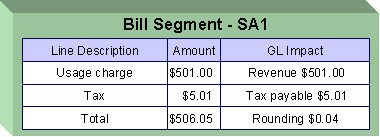Rounding At The End
The following is an example of a simple bill segment with three bill lines.

The first two bill lines are calculated using simple rate components that have a precision of.01. The last bill line is special, it rounds the bill up to the next highest 0.05 (this is an example from a country that doesn't have cents, their smallest coin is 0.05). The following would be necessary to calculate the last bill line:
- The rate component would be an exact charge rate component
- Its value (i.e., the exact charge) would be calculated using a value calculation algorithm that sums the first two rate components and rounds them up to the nearest.05. Refer to RCVL-RNDXRF for a value calculation algorithm that can perform this function.
An alternative approach is to do the following:
- Use a summary rate component to calculate the exact charge. This
rate component would require the following characteristics:
- FCPO
- Non printing
- Rounding type would be round up
- Precision would be 0.05
- Reference the summary rate component as the exact charge rate component's value
